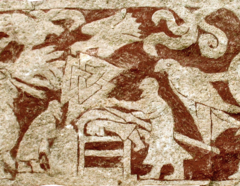
The blood eagle was a method of ritual execution as detailed in late skaldic poetry. According to the two instances mentioned in the Christian sagas, the victims (in both cases members of royal families) were placed in a prone position, their ribs severed from the spine with a sharp tool, and their lungs pulled through the opening to create a pair of "wings". There has been continuing debate about whether the rite was a literary invention of the original texts, a mistranslation of the texts themselves, or an authentic historical practice.[1][2][3]
- ^ Frank, Roberta (1984). "Viking atrocity and Skaldic verse: The Rite of the Blood-Eagle". English Historical Review. XCIX (CCCXCI). Oxford Journals: 332–343. doi:10.1093/ehr/XCIX.CCCXCI.332.
- ^ Tracy, Larissa (2012). Torture and Brutality in Medieval Literature: Negotiations of National Identity. DS Brewer. pp. 109–111. ISBN 9781843842880. Archived from the original on 2015-09-23. Retrieved 2015-03-30.
- ^ Dash, Mike (18 March 2013). "The Vengeance of Ivarr the Boneless". Smithsonian.com. Smithsonian. Retrieved 30 March 2015.